Critical Appraisal Skills: Evaluating Healthcare with CASP Tool
VerifiedAdded on 2023/06/13
|8
|2044
|219
Report
AI Summary
This report presents a critical appraisal of a research study focusing on the effectiveness of nurse practitioner (NP) services in emergency departments (ED) using the Critical Appraisal Skills Programme (CASP) tool. The appraisal assesses the validity of the study's results, including the randomization pr...
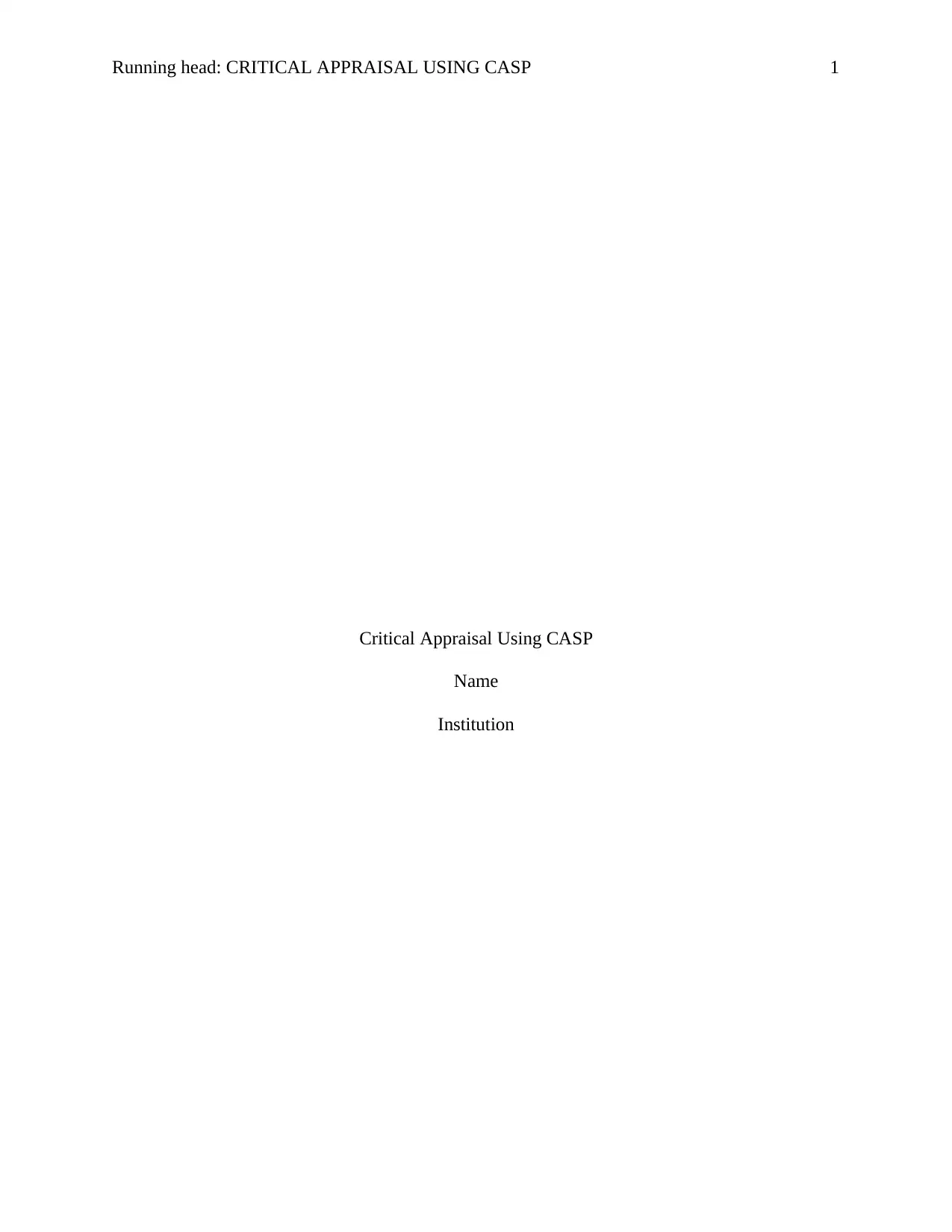
Running head: CRITICAL APPRAISAL USING CASP 1
Critical Appraisal Using CASP
Name
Institution
Critical Appraisal Using CASP
Name
Institution
Paraphrase This Document
Need a fresh take? Get an instant paraphrase of this document with our AI Paraphraser

CRITICAL APPRAISAL USING CASP 2
CRITICAL APPRAISAL USING CASP
A. Are the results valid?
2. Was the assignment of patients to treatments randomized?
The assignment to the treatments was randomized in the study. These included the
patients presenting with pain to receive the standard emergency department medical care or even
NP care. The primary probers were blinded to treatment assignment for the analysis of data. The
primary outcome measure stood the proportion of patients that received analgesia within thirty
minutes from being observed by the care cohort. The secondary outcome measures were time to
analgesia from presentation alongside documentation of and alterations in the scores of pains.
3. Were all of the patients who entered the trial properly accounted for at its conclusion?
Was follow up complete
The patients who entered the trial properly accounted for at its conclusion based on
complete follow-up. The researchers accounted for all the 260 patients were randomized. For
example, 128 received the standard care led by the medical practitioner while 130 received the
NP care. The authors excluded two patients because of incomplete consent forms. This gives a
clear account of all the patients that entered the study. Further. The proportions of patients that
received the analgesia under thirty minutes from being observed stood at 49.2 percent where
n=64.0 in the NP cohort while 29.70 percent where n=38.0 was in standard cohort. The variation
of 19.50 percent at CI of 95% was noted. Amongst 165.0 patients that were given the analgesia,
sixty-four of them or 84.20 percent analgesia within 0.5 hours in NP cohort as opposed to 38.0 or
42.70 percent in standard care cohort, a variation in the proportion of 41.50 percent at CI of 95%.
5.
CRITICAL APPRAISAL USING CASP
A. Are the results valid?
2. Was the assignment of patients to treatments randomized?
The assignment to the treatments was randomized in the study. These included the
patients presenting with pain to receive the standard emergency department medical care or even
NP care. The primary probers were blinded to treatment assignment for the analysis of data. The
primary outcome measure stood the proportion of patients that received analgesia within thirty
minutes from being observed by the care cohort. The secondary outcome measures were time to
analgesia from presentation alongside documentation of and alterations in the scores of pains.
3. Were all of the patients who entered the trial properly accounted for at its conclusion?
Was follow up complete
The patients who entered the trial properly accounted for at its conclusion based on
complete follow-up. The researchers accounted for all the 260 patients were randomized. For
example, 128 received the standard care led by the medical practitioner while 130 received the
NP care. The authors excluded two patients because of incomplete consent forms. This gives a
clear account of all the patients that entered the study. Further. The proportions of patients that
received the analgesia under thirty minutes from being observed stood at 49.2 percent where
n=64.0 in the NP cohort while 29.70 percent where n=38.0 was in standard cohort. The variation
of 19.50 percent at CI of 95% was noted. Amongst 165.0 patients that were given the analgesia,
sixty-four of them or 84.20 percent analgesia within 0.5 hours in NP cohort as opposed to 38.0 or
42.70 percent in standard care cohort, a variation in the proportion of 41.50 percent at CI of 95%.
5.

CRITICAL APPRAISAL USING CASP 3
The patients stood all same at the baseline or at beginning of the study in terms of
age, sex and social factors. They were all patients with pain were allocated at random to get other
standard Emergency Department medical care or NP care.
6.
The cohorts stood equally treated besides experimental interventions. All patients with
pain got assigned at random to receive standard emergency department medical care or the NP
care. Both groups were treated based on the National Statement on Ethical Conduct in Human
Research. All of the patients were treated based on the approval got from the suitable university
alongside hospital human research and ethics committee. Each patient was asked to willingly
give their written informed consent prior to take part in the research.
Each patient was accorded same treatment. The clinical study assistants utilized the
examination cubicle when recruiting as well as consent patients alongside gather baseline
demographic info without any discrimination (Burls, 2014). Each participant went through same
randomization procedure through assigning sequence of 4 and produced using computer random
number generator. Every allocation adhered to same maintained generated sequence.
Moreover, each treating staff was according same info prior to commencement
(LoBiondo-Wood & Haber, 2017). The patient were analyzed as randomized and displayed in
the table form showing time to analgesia for each randomized participants utilizing Kaplan-
Meier examination. Patients were effectively analyzed to the cohorts of randomization. Data
from 258 participants have analyzed in respective groups to which the patients were randomized.
One hundred and twenty eight patients got standard ED medical-driven care whereas one
hundred and thirty received NP care.
The patients stood all same at the baseline or at beginning of the study in terms of
age, sex and social factors. They were all patients with pain were allocated at random to get other
standard Emergency Department medical care or NP care.
6.
The cohorts stood equally treated besides experimental interventions. All patients with
pain got assigned at random to receive standard emergency department medical care or the NP
care. Both groups were treated based on the National Statement on Ethical Conduct in Human
Research. All of the patients were treated based on the approval got from the suitable university
alongside hospital human research and ethics committee. Each patient was asked to willingly
give their written informed consent prior to take part in the research.
Each patient was accorded same treatment. The clinical study assistants utilized the
examination cubicle when recruiting as well as consent patients alongside gather baseline
demographic info without any discrimination (Burls, 2014). Each participant went through same
randomization procedure through assigning sequence of 4 and produced using computer random
number generator. Every allocation adhered to same maintained generated sequence.
Moreover, each treating staff was according same info prior to commencement
(LoBiondo-Wood & Haber, 2017). The patient were analyzed as randomized and displayed in
the table form showing time to analgesia for each randomized participants utilizing Kaplan-
Meier examination. Patients were effectively analyzed to the cohorts of randomization. Data
from 258 participants have analyzed in respective groups to which the patients were randomized.
One hundred and twenty eight patients got standard ED medical-driven care whereas one
hundred and thirty received NP care.
⊘ This is a preview!⊘
Do you want full access?
Subscribe today to unlock all pages.

Trusted by 1+ million students worldwide
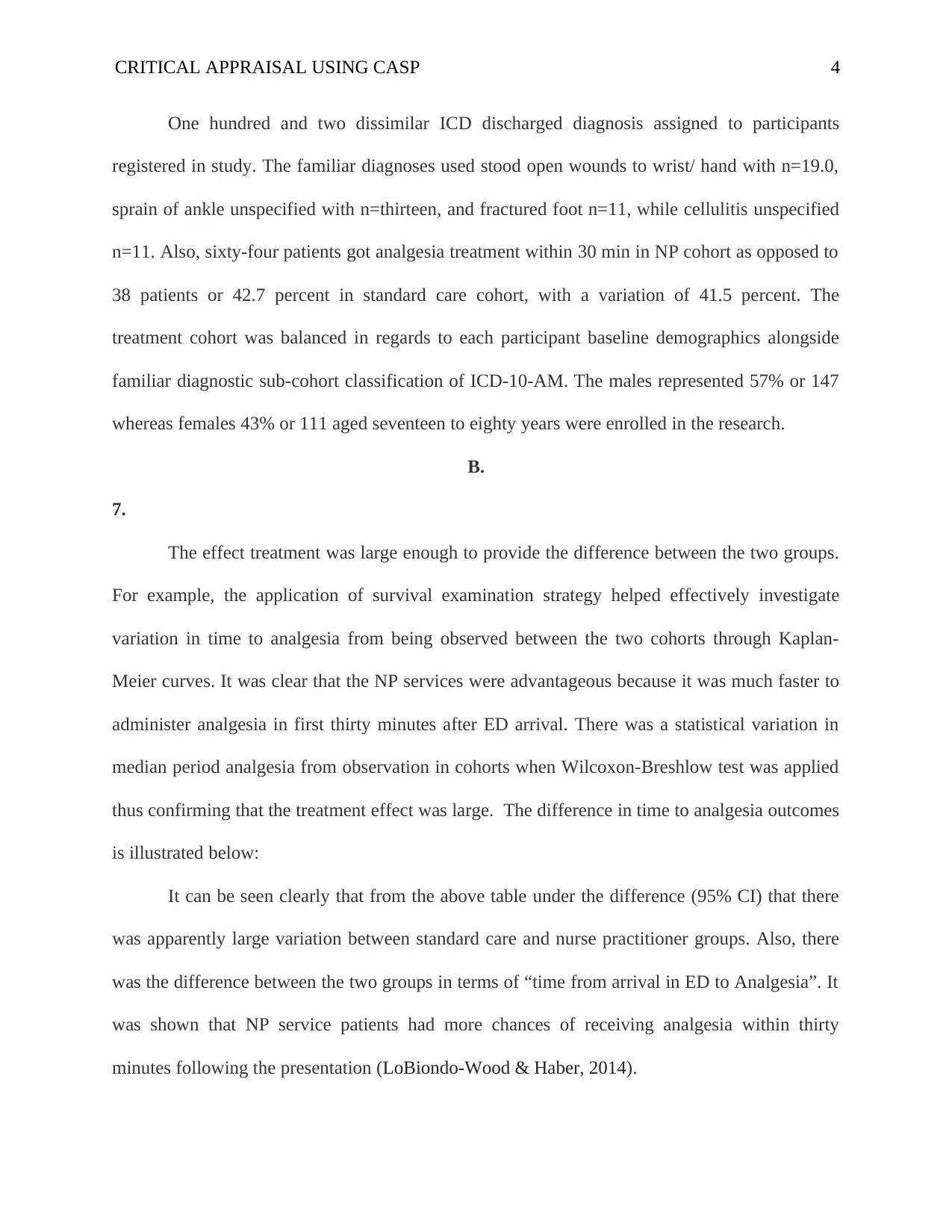
CRITICAL APPRAISAL USING CASP 4
One hundred and two dissimilar ICD discharged diagnosis assigned to participants
registered in study. The familiar diagnoses used stood open wounds to wrist/ hand with n=19.0,
sprain of ankle unspecified with n=thirteen, and fractured foot n=11, while cellulitis unspecified
n=11. Also, sixty-four patients got analgesia treatment within 30 min in NP cohort as opposed to
38 patients or 42.7 percent in standard care cohort, with a variation of 41.5 percent. The
treatment cohort was balanced in regards to each participant baseline demographics alongside
familiar diagnostic sub-cohort classification of ICD-10-AM. The males represented 57% or 147
whereas females 43% or 111 aged seventeen to eighty years were enrolled in the research.
B.
7.
The effect treatment was large enough to provide the difference between the two groups.
For example, the application of survival examination strategy helped effectively investigate
variation in time to analgesia from being observed between the two cohorts through Kaplan-
Meier curves. It was clear that the NP services were advantageous because it was much faster to
administer analgesia in first thirty minutes after ED arrival. There was a statistical variation in
median period analgesia from observation in cohorts when Wilcoxon-Breshlow test was applied
thus confirming that the treatment effect was large. The difference in time to analgesia outcomes
is illustrated below:
It can be seen clearly that from the above table under the difference (95% CI) that there
was apparently large variation between standard care and nurse practitioner groups. Also, there
was the difference between the two groups in terms of “time from arrival in ED to Analgesia”. It
was shown that NP service patients had more chances of receiving analgesia within thirty
minutes following the presentation (LoBiondo-Wood & Haber, 2014).
One hundred and two dissimilar ICD discharged diagnosis assigned to participants
registered in study. The familiar diagnoses used stood open wounds to wrist/ hand with n=19.0,
sprain of ankle unspecified with n=thirteen, and fractured foot n=11, while cellulitis unspecified
n=11. Also, sixty-four patients got analgesia treatment within 30 min in NP cohort as opposed to
38 patients or 42.7 percent in standard care cohort, with a variation of 41.5 percent. The
treatment cohort was balanced in regards to each participant baseline demographics alongside
familiar diagnostic sub-cohort classification of ICD-10-AM. The males represented 57% or 147
whereas females 43% or 111 aged seventeen to eighty years were enrolled in the research.
B.
7.
The effect treatment was large enough to provide the difference between the two groups.
For example, the application of survival examination strategy helped effectively investigate
variation in time to analgesia from being observed between the two cohorts through Kaplan-
Meier curves. It was clear that the NP services were advantageous because it was much faster to
administer analgesia in first thirty minutes after ED arrival. There was a statistical variation in
median period analgesia from observation in cohorts when Wilcoxon-Breshlow test was applied
thus confirming that the treatment effect was large. The difference in time to analgesia outcomes
is illustrated below:
It can be seen clearly that from the above table under the difference (95% CI) that there
was apparently large variation between standard care and nurse practitioner groups. Also, there
was the difference between the two groups in terms of “time from arrival in ED to Analgesia”. It
was shown that NP service patients had more chances of receiving analgesia within thirty
minutes following the presentation (LoBiondo-Wood & Haber, 2014).
Paraphrase This Document
Need a fresh take? Get an instant paraphrase of this document with our AI Paraphraser
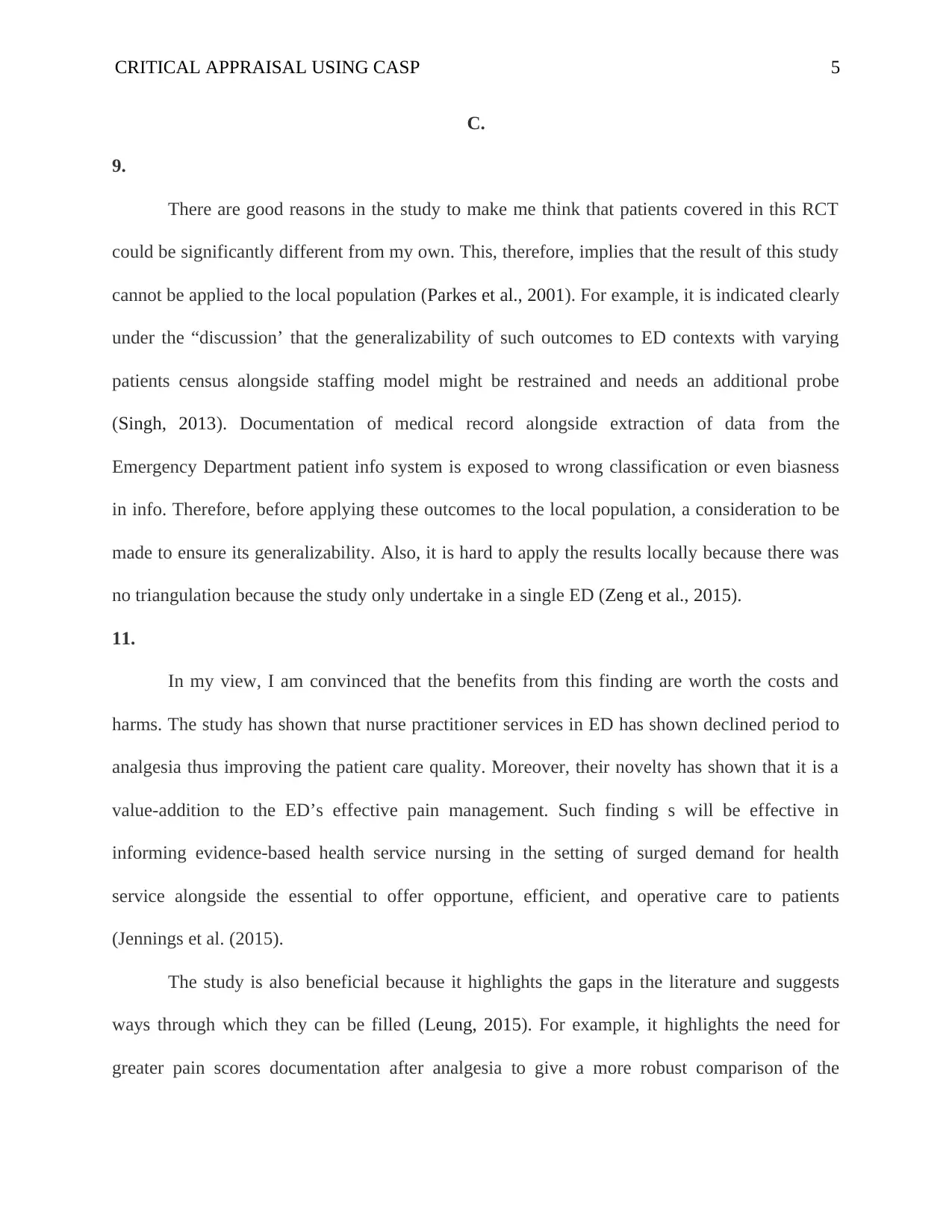
CRITICAL APPRAISAL USING CASP 5
C.
9.
There are good reasons in the study to make me think that patients covered in this RCT
could be significantly different from my own. This, therefore, implies that the result of this study
cannot be applied to the local population (Parkes et al., 2001). For example, it is indicated clearly
under the “discussion’ that the generalizability of such outcomes to ED contexts with varying
patients census alongside staffing model might be restrained and needs an additional probe
(Singh, 2013). Documentation of medical record alongside extraction of data from the
Emergency Department patient info system is exposed to wrong classification or even biasness
in info. Therefore, before applying these outcomes to the local population, a consideration to be
made to ensure its generalizability. Also, it is hard to apply the results locally because there was
no triangulation because the study only undertake in a single ED (Zeng et al., 2015).
11.
In my view, I am convinced that the benefits from this finding are worth the costs and
harms. The study has shown that nurse practitioner services in ED has shown declined period to
analgesia thus improving the patient care quality. Moreover, their novelty has shown that it is a
value-addition to the ED’s effective pain management. Such finding s will be effective in
informing evidence-based health service nursing in the setting of surged demand for health
service alongside the essential to offer opportune, efficient, and operative care to patients
(Jennings et al. (2015).
The study is also beneficial because it highlights the gaps in the literature and suggests
ways through which they can be filled (Leung, 2015). For example, it highlights the need for
greater pain scores documentation after analgesia to give a more robust comparison of the
C.
9.
There are good reasons in the study to make me think that patients covered in this RCT
could be significantly different from my own. This, therefore, implies that the result of this study
cannot be applied to the local population (Parkes et al., 2001). For example, it is indicated clearly
under the “discussion’ that the generalizability of such outcomes to ED contexts with varying
patients census alongside staffing model might be restrained and needs an additional probe
(Singh, 2013). Documentation of medical record alongside extraction of data from the
Emergency Department patient info system is exposed to wrong classification or even biasness
in info. Therefore, before applying these outcomes to the local population, a consideration to be
made to ensure its generalizability. Also, it is hard to apply the results locally because there was
no triangulation because the study only undertake in a single ED (Zeng et al., 2015).
11.
In my view, I am convinced that the benefits from this finding are worth the costs and
harms. The study has shown that nurse practitioner services in ED has shown declined period to
analgesia thus improving the patient care quality. Moreover, their novelty has shown that it is a
value-addition to the ED’s effective pain management. Such finding s will be effective in
informing evidence-based health service nursing in the setting of surged demand for health
service alongside the essential to offer opportune, efficient, and operative care to patients
(Jennings et al. (2015).
The study is also beneficial because it highlights the gaps in the literature and suggests
ways through which they can be filled (Leung, 2015). For example, it highlights the need for
greater pain scores documentation after analgesia to give a more robust comparison of the
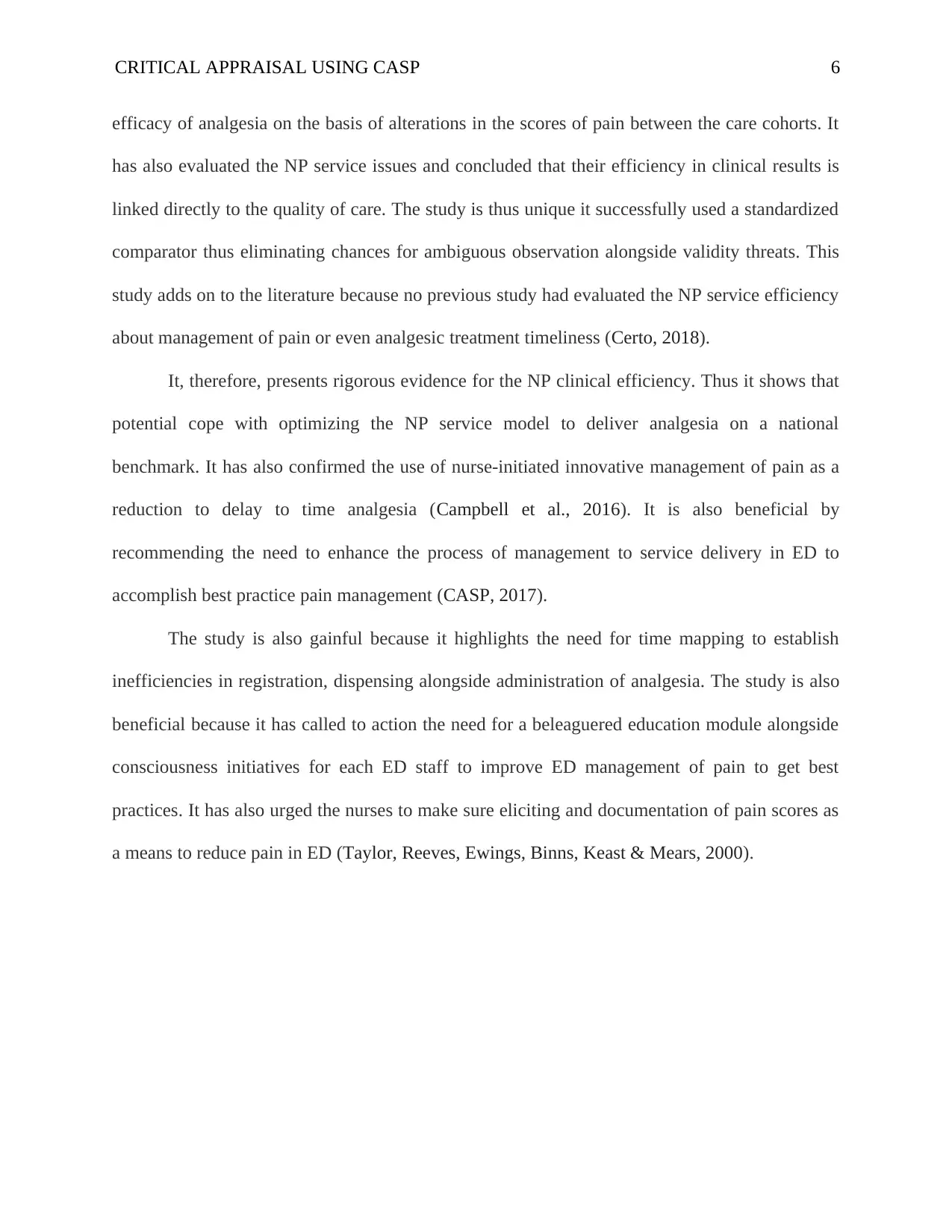
CRITICAL APPRAISAL USING CASP 6
efficacy of analgesia on the basis of alterations in the scores of pain between the care cohorts. It
has also evaluated the NP service issues and concluded that their efficiency in clinical results is
linked directly to the quality of care. The study is thus unique it successfully used a standardized
comparator thus eliminating chances for ambiguous observation alongside validity threats. This
study adds on to the literature because no previous study had evaluated the NP service efficiency
about management of pain or even analgesic treatment timeliness (Certo, 2018).
It, therefore, presents rigorous evidence for the NP clinical efficiency. Thus it shows that
potential cope with optimizing the NP service model to deliver analgesia on a national
benchmark. It has also confirmed the use of nurse-initiated innovative management of pain as a
reduction to delay to time analgesia (Campbell et al., 2016). It is also beneficial by
recommending the need to enhance the process of management to service delivery in ED to
accomplish best practice pain management (CASP, 2017).
The study is also gainful because it highlights the need for time mapping to establish
inefficiencies in registration, dispensing alongside administration of analgesia. The study is also
beneficial because it has called to action the need for a beleaguered education module alongside
consciousness initiatives for each ED staff to improve ED management of pain to get best
practices. It has also urged the nurses to make sure eliciting and documentation of pain scores as
a means to reduce pain in ED (Taylor, Reeves, Ewings, Binns, Keast & Mears, 2000).
efficacy of analgesia on the basis of alterations in the scores of pain between the care cohorts. It
has also evaluated the NP service issues and concluded that their efficiency in clinical results is
linked directly to the quality of care. The study is thus unique it successfully used a standardized
comparator thus eliminating chances for ambiguous observation alongside validity threats. This
study adds on to the literature because no previous study had evaluated the NP service efficiency
about management of pain or even analgesic treatment timeliness (Certo, 2018).
It, therefore, presents rigorous evidence for the NP clinical efficiency. Thus it shows that
potential cope with optimizing the NP service model to deliver analgesia on a national
benchmark. It has also confirmed the use of nurse-initiated innovative management of pain as a
reduction to delay to time analgesia (Campbell et al., 2016). It is also beneficial by
recommending the need to enhance the process of management to service delivery in ED to
accomplish best practice pain management (CASP, 2017).
The study is also gainful because it highlights the need for time mapping to establish
inefficiencies in registration, dispensing alongside administration of analgesia. The study is also
beneficial because it has called to action the need for a beleaguered education module alongside
consciousness initiatives for each ED staff to improve ED management of pain to get best
practices. It has also urged the nurses to make sure eliciting and documentation of pain scores as
a means to reduce pain in ED (Taylor, Reeves, Ewings, Binns, Keast & Mears, 2000).
⊘ This is a preview!⊘
Do you want full access?
Subscribe today to unlock all pages.

Trusted by 1+ million students worldwide

CRITICAL APPRAISAL USING CASP 7
References
Burls, A. (2014). What is critical appraisal?. Hayward Medical Communications.
Campbell, S. J., Nery, S. V., Doi, S. A., Gray, D. J., Magalhães, R. J. S., McCarthy, J. S., ... &
Clements, A. C. (2016). Complexities and perplexities: a critical appraisal of the evidence
for soil-transmitted helminth infection-related morbidity. PLoS neglected tropical
diseases, 10(5), e0004566.
CASP, U. (2017). Critical Appraisal Skills Programme (CASP). Qualitative research
checklist, 31, 13.
Certo, S. C. (2018). Supervision: Concepts and skill-building. McGraw-Hill Education.
Jennings, N., et al. (2015). “Evaluating Emergency Nurse Practitioner Service Effectiveness on
Achieving Timely Analgesia: A Pragmatic Randomized Controlled Trial.” Academic
Emergency Medicine 22 (6): 676-684’.
http://ezproxy.utas.ed.au/login?url=https://elibrary.utas.edu.au/utas/items/6754d1e5-
b9e8-41ec-9878-ed91bd2ef/0/?attachment.uuid=fb8442b2-e216-4dd2-a20f-f732fddcdc71
Leung, L. (2015). Validity, reliability, and generalizability in qualitative research. Journal of
family medicine and primary care, 4(3), 324.
LoBiondo-Wood, G., & Haber, J. (2014). Nursing Research-E-Book: Methods and Critical
Appraisal for Evidence-Based Practice. Elsevier Health Sciences.
LoBiondo-Wood, G., & Haber, J. (2017). Nursing Research-E-Book: Methods and Critical
Appraisal for Evidence-Based Practice. Elsevier Health Sciences.
Parkes, J., Hyde, C., Deeks, J. J., Milne, R., Pujol-Ribera, E., & Foz, G. (2001). Teaching critical
appraisal skills in health care settings. Cochrane Database Syst Rev, 3(3).
References
Burls, A. (2014). What is critical appraisal?. Hayward Medical Communications.
Campbell, S. J., Nery, S. V., Doi, S. A., Gray, D. J., Magalhães, R. J. S., McCarthy, J. S., ... &
Clements, A. C. (2016). Complexities and perplexities: a critical appraisal of the evidence
for soil-transmitted helminth infection-related morbidity. PLoS neglected tropical
diseases, 10(5), e0004566.
CASP, U. (2017). Critical Appraisal Skills Programme (CASP). Qualitative research
checklist, 31, 13.
Certo, S. C. (2018). Supervision: Concepts and skill-building. McGraw-Hill Education.
Jennings, N., et al. (2015). “Evaluating Emergency Nurse Practitioner Service Effectiveness on
Achieving Timely Analgesia: A Pragmatic Randomized Controlled Trial.” Academic
Emergency Medicine 22 (6): 676-684’.
http://ezproxy.utas.ed.au/login?url=https://elibrary.utas.edu.au/utas/items/6754d1e5-
b9e8-41ec-9878-ed91bd2ef/0/?attachment.uuid=fb8442b2-e216-4dd2-a20f-f732fddcdc71
Leung, L. (2015). Validity, reliability, and generalizability in qualitative research. Journal of
family medicine and primary care, 4(3), 324.
LoBiondo-Wood, G., & Haber, J. (2014). Nursing Research-E-Book: Methods and Critical
Appraisal for Evidence-Based Practice. Elsevier Health Sciences.
LoBiondo-Wood, G., & Haber, J. (2017). Nursing Research-E-Book: Methods and Critical
Appraisal for Evidence-Based Practice. Elsevier Health Sciences.
Parkes, J., Hyde, C., Deeks, J. J., Milne, R., Pujol-Ribera, E., & Foz, G. (2001). Teaching critical
appraisal skills in health care settings. Cochrane Database Syst Rev, 3(3).
Paraphrase This Document
Need a fresh take? Get an instant paraphrase of this document with our AI Paraphraser
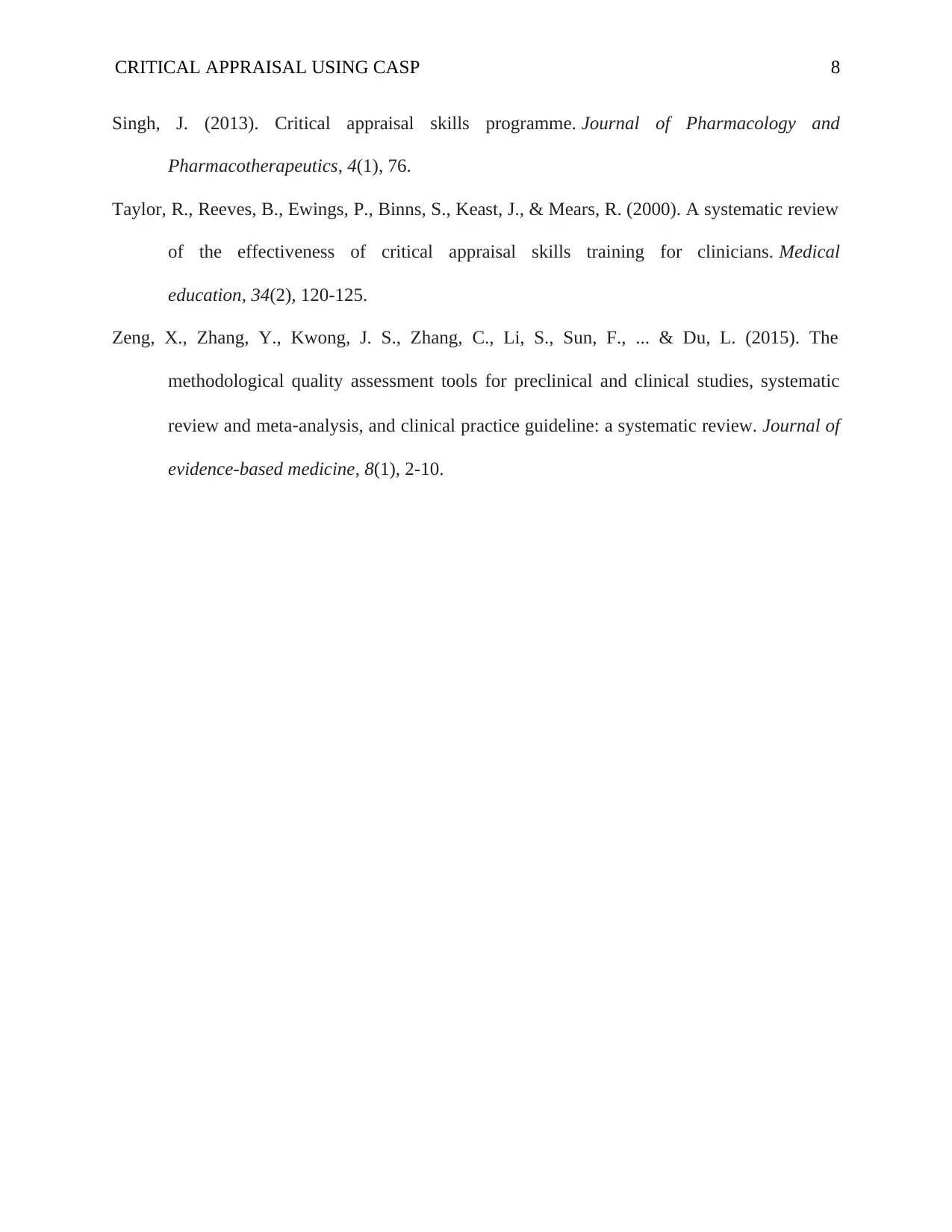
CRITICAL APPRAISAL USING CASP 8
Singh, J. (2013). Critical appraisal skills programme. Journal of Pharmacology and
Pharmacotherapeutics, 4(1), 76.
Taylor, R., Reeves, B., Ewings, P., Binns, S., Keast, J., & Mears, R. (2000). A systematic review
of the effectiveness of critical appraisal skills training for clinicians. Medical
education, 34(2), 120-125.
Zeng, X., Zhang, Y., Kwong, J. S., Zhang, C., Li, S., Sun, F., ... & Du, L. (2015). The
methodological quality assessment tools for preclinical and clinical studies, systematic
review and meta‐analysis, and clinical practice guideline: a systematic review. Journal of
evidence-based medicine, 8(1), 2-10.
Singh, J. (2013). Critical appraisal skills programme. Journal of Pharmacology and
Pharmacotherapeutics, 4(1), 76.
Taylor, R., Reeves, B., Ewings, P., Binns, S., Keast, J., & Mears, R. (2000). A systematic review
of the effectiveness of critical appraisal skills training for clinicians. Medical
education, 34(2), 120-125.
Zeng, X., Zhang, Y., Kwong, J. S., Zhang, C., Li, S., Sun, F., ... & Du, L. (2015). The
methodological quality assessment tools for preclinical and clinical studies, systematic
review and meta‐analysis, and clinical practice guideline: a systematic review. Journal of
evidence-based medicine, 8(1), 2-10.
1 out of 8
Related Documents
Your All-in-One AI-Powered Toolkit for Academic Success.
+13062052269
info@desklib.com
Available 24*7 on WhatsApp / Email
![[object Object]](/_next/static/media/star-bottom.7253800d.svg)
Unlock your academic potential
© 2024 | Zucol Services PVT LTD | All rights reserved.




